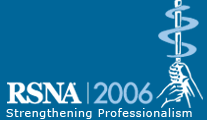
Abstract Archives of the RSNA, 2006
Unni K. Udayasankar MD, Presenter: Nothing to Disclose
Mannudeep Karanvirsingh Kalra MD, Abstract Co-Author: Research grant, General Electric Company
Jianhai Li MD, Abstract Co-Author: Nothing to Disclose
Thomas Louis Toth, Abstract Co-Author: Employee, General Electric Company
John L Seamans MS, Abstract Co-Author: Employee, General Electric Company
William Clark Small MD,PhD, Abstract Co-Author: Nothing to Disclose
Sandra Miller Waldrop PhD, Abstract Co-Author: Nothing to Disclose
et al, Abstract Co-Author: Nothing to Disclose
To evaluate patient size compensated (PSC) automatic tube current modulation (ATCM) for optimization of image quality and radiation dose in patients undergoing abdominal-pelvic CT.
100 patients (age=19-86 years, mean age=50 years, M:F=57:43) underwent abdominal-pelvic CT with 64 slice multidetector row CT (MDCT) (GE VCT) using PSC ATCM. The technique estimated noise indices based on the square root projection area of patients from the scout image. Scan parameters included 120 kVp, 0.984:1 pitch, 64x0.625 detector collimation, 39.37 table speed and 5 mm slice thickness. Mean tube current-time product was calculated for each study. Two radiologists independently evaluated the studies and graded the image quality for noise, and diagnostic acceptability at the levels of diaphragmatic aspect of liver, porta hepatis, and acetabulum on a 5 point scale (1 = unacceptable; 5 = excellent), while streak artifacts were graded on 3 point scale (1= no streaks). Noise was measured in the liver at the level of the porta along with antero-posterior and transverse diameters. Square root projection areas were also recorded from the scout images in each case.
Regardless of patient size, PSC ATCM provided acceptable image quality in all patients. The average noise index used for CT was 15.6 (range of 9.6- 28.7). A good inter-observer agreement was noted in terms of image noise and diagnostic acceptability (κ=0.71 p<0.01, κ=0.77 p<0.01). The noise index suggested was better correlated with projection area (R²= 0.73, p<0.01) when compared to antero-posterior (R²=0.43, p<0.01) or transverse (R²= 0.32, p<0.01) diameters. However, there was a weak positive correlation between the average mAs and the square root of projection area obtained from the lateral scout (R=0.25, p<0.01). The average CTDI volume of the study was 14.59 mGy (range of 3.4 to 32.3).
PSC ATCM leads to less operator dependence in selecting the appropriate noise index. The image quality and noise levels obtained by this technique are diagnostically acceptable.
PSC ATCM technique helps the technologist in choosing the appropriate noise indices in patients undergoing MDCT of abdomen and pelvis.
Udayasankar, U,
Kalra, M,
Li, J,
Toth, T,
Seamans, J,
Small, W,
Waldrop, S,
et al, ,
Multidetector Scanning of the Abdomen and Pelvis: A Study for Evaluation of Size Compensated Automatic Tube Current Modulation Technique in 100 Subjects. Radiological Society of North America 2006 Scientific Assembly and Annual Meeting, November 26 - December 1, 2006 ,Chicago IL.
http://archive.rsna.org/2006/4441276.html

